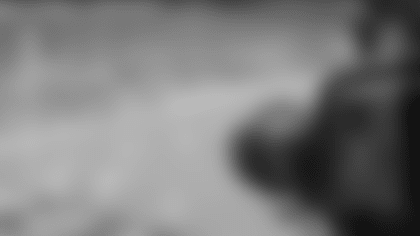**
BB:** Just another day here grinding through camp. [We'll] try to build off what we did yesterday and move into some situational stuff for Carolina, where we would normally be for a regular season work week, kind of. We're still working on a lot of things that we just need to work on. I would say just grinding it out.
Q: Jonas Gray is a guy who has been in the league awhile but hasn't played much. What have you seen from him?
BB: Hard working kid. Worked hard in the offseason, worked hard in the spring and he's worked hard in training camp; been out there every day making progress and improving. We'll see how it goes. He's done everything we've asked him to do.
Q: How have you seen the progression between Tom Brady and Brandon LaFell as camp has gone on?
BB: Again, both players have been out there and able to work together on a daily basis. I think it continues to improve. Again, I think we have a long way to go. But definitely making progress, heading in the right direction. I think probably each player is kind of getting used to the other one a little bit. That's normal.
Q: What do you like about Brandon LaFell? What have you learned about him over the last few months?
BB: He's been good. He's been very diligent in trying to learn his assignments, learn the plays. He's a tough kid. He's played for us in the kicking game, he's given us some plays there, which at that position it's always good to get those [plays] out of those receivers. Those are kind of like bonus plays. I think he's been very competitive. Obviously he's a big target. Again, he's gotten better at the routes that we've run. I thought the deep out route that he ran in the game was good. He created a lot of separation on that. He's got a good skill set; a little different than some of our other guys, but good and he's tough.
Q: Is it more difficult to get a bigger, lankier wide receiver integrated into special teams than a shorter, quicker guy?
BB: I'd say probably the bigger guy might have an advantage. Other than in the return game, although Brandon has worked for us on kickoff returns as well. No, I think size and strength are big attributes that you have to have to block or take on blockers, unless it's a return guy. No, I think those are things that kind of work in his favor and he's did in Carolina. He's tough and he's competitive and he does a good job there. Just another way that he can contribute to the team. I think that's really been one of the best things about Brandon is just he's finding different ways to contribute, whether it's blocking, receiving, special teams. Whatever we've asked him to do, he's done it and done it well. He's gotten better at it. I think he'll be able to carve out a role for himself here. It might be a big one, I don't know, we'll see.
Q: Is that a huge consideration when you starting looking at the position groups toward cut down day – is 'OK, this guy also plays two of these special teams and this one doesn't play on any.' I'm really looking at the wide receiver group. Danny Amendola can return and Julian Edelman obviously returns and LaFell has some. Kenbrell Thompkins, I'm not sure if he does anything. Does it all weigh in?
BB: Sure it does. And especially in the positions where you normally don't get – you see returners come from the wide receiver group, I'd say that's where most of them come from, not all but most of them, come from. When you get contributions from those guys in coverage or you take an offensive or a defensive lineman that generally doesn't have much of a role in the kicking game other than field goal and they can contribute for you on a team or two then that's just bonus that you don't normally get. So, sure. I think everyone counts, you bet.
Q: When you're looking for a kick returner, other than the physical stuff, what are some of the things that make a good kick returner? I imagine vision is one of the first things that pops up.
BB: Well, yeah, definitely vision is important. Speed is important because the faster you can get the ball from the goal line or wherever it comes down up into that 15, 20-yard line area then the more you can avoid that outside guy, whoever it is. You can't really block everybody. Well, you can but once you start double teaming to create running lanes then you run out of blockers and you try to let somebody go – usually the backside guy, the guy farthest from the ball, that type of thing. So, fast guys can get past them before they're able to come down and make the play. So, speed and then either some combination of quickness and power to break tackles. Somehow or another returners to be good have to be able to make some yards on their own. They have to be able to avoid them or be strong to run through them, as well as have good vision and find the holes. Kickoff return is a little different than punt returns because you have so many guys coming down at the same time and you have a chance to generally build some momentum, build some speed and create on the run. Whereas a lot of times on punt returns, they're right there on top of you, you have to make a quick decision. There's only two guys down there so usually the gunners, unless the ball has a lot of hang time, but there's usually that first wave of just two guys or however many of them get down there and then you have that second wave. So, the ball handling is quite a bit different, I'd say harder, on punts. Certainly the decision making once you get into plus-50 punting and things like that are a little bit different other than making the come out of the end zone or not come out of the end zone [decision] on kick returns. There aren't a lot of guys in the league that do both. There certainly are some but there are quite a few guys that do one or the other because the skills really are a little bit different.
Q: In preseason games, do you stick to the rules you have during the regular season or because they have an opportunity to return the kick is it, 'Just go do it and show us what you've got'?
BB: I'd say generally speaking you want to try to return when you can. At the same time, we don't want to coach bad decision making or coach bad fundamentals. Generally speaking we tell them that if it's in the gray area, let's go with it.
Q: How important are these preseason games for the defensive backs? Obviously with points of emphasis in the secondary around illegal contact, are these preseason games more important than normal to get a feel for what's allowed?
BB: They're probably pretty important for everybody. There's probably as many offensive holding, hands to the face, defensive hands to the face, I don't think we've ever seen than many of those called either. It's like it's for everybody. Linebackers, the illegal contact on the tight ends and re-routing receivers and so forth. Really, I think it has application to all the defensive skill players and offensive and defensive linemen with all the holding, hands to the face, roll blocks. Again, there are no new rules but certainly a lot of calls in those areas.
Q: Devin McCourty told us that's it a little bit different for a safety as opposed to cornerback right on the line of scrimmage. From what you've seen on the film, what is the biggest difference in that rule as it applies to corners and safeties?
BB: Well, they're usually not as close to the receivers. I mean, they could be in man coverage but if it's not man coverage or for Devin, where he's playing a lot of deep field coverage, maybe you're not that close to the receivers. They're already into their route. He's breaking on the ball. He's usually covering more of an area. Even when they're in man coverage, a lot of times that's for depth as opposed to right on the line so they know they can't contact a guy after he goes five yards and most of the time they're not really in that breakpoint area until that 8 to 12-yard range so it really doesn't come up unless the receiver comes close to the defender or runs right into him then you have it. Yeah, I'd say it's definitely less frequent.
Q: On the kickoff returns, is it common to break down the film and see a guy who just took a touchback and you notice there was a mistake, there was an opportunity that he didn't see?
BB: Again, when the kickoff returner is back there catching the ball, I'd say the three things that affect him the most are the depth of the kick, the hang time of the kick and the posture that he's in when he catches it. So, no matter how deep you are, if you're waiting for the ball and going forward and rolling into the catch, it's a little different than if you're backing up or going sideways or that type of thing because the momentum at the start of it is a lot different. You hear people refer to a depth in the end zone but I don't really think that's the final story because a ball with no hang time deep in the end zone is a lot more favorable return than a ball that's not as deep in the end zone with quite a bit of hang time. There's the combination of that. So, it's a judgment but all that is going on. Really the returner doesn't see the blocking pattern develop until he's on the 10 or 15-yard line usually. Some of those blocks are set early but a lot of them don't take place – you have your front line blocks but the rest of those blocks don't take place until the coverage team is inside the 30 for sure. So by the time he gets the ball and brings it out, those blocks take place. That's when the lanes do or don't line up. It would be pretty hard for him to catch the ball and feel like, 'Oh my God, I missed a big hole there,' because it's just too early to see it.
Q: What are your thoughts on the practice squad roster expanding to potentially 10 players this season?
BB: Whatever the rules are, we'll work with them.
Q: When you're making decisions as to who may or may not make that practice squad – from the players that are available to you – do you look at the roster that you have and say, 'We could use a little more depth here, it would be helpful to have a guy at this position?' Or do you look at just the overall potential of the player?
BB: That's a great question, but it's really both. I think you have to have enough players to practice. So, sometimes if you go shorter in a position on your 53-man roster you can subsidize that with a player or two on the practice squad so it doesn't screw your practices up and you're able to maintain a normal flow of practice. You have to have receivers to run patterns, you have to have linemen to block, you have to have DBs to cover. Somewhere along the line you need all of those things. If you're short, then balancing out the roster with numbers, that's certainly part of it. At the same time, the players you want on the practice squad, you would like for them to be guys that you think could develop and eventually become roster players. You don't really want to let – if you feel that way about a player, you don't want to let him go for a player you don't think is a roster player even though he plays the position you kind of need, if you will. It's a balance. Really it's similar to when you pick out your 53-man roster. There are times when you end up picking a player and keep him on your roster because of the position he plays. There may be a better player at a different position but you have more depth there. You just can't afford that extra guy. You almost need whatever it is that you need. Then I'd say the practice squad is then residual of that. Hopefully you can balance it out, but it usually doesn't work out quite that way. You usually have some of the same situations on the practice squad. Yeah, you have a couple guys at the position that you need, but then here's somebody else that you think has more potential as a player but you really need something else to kind of help you practice. You see a lot of juggling of practice squads throughout the first six weeks, half the season and that's part of it. You getting injuries or your roster changes a little bit and you need players on your practice squad to fill in those gaps. Or you find somebody that you like and think, 'This guy has a chance to develop on our practice squad.' You're willing to take one of those spots, even if it's a position of depth to work with that player because you like him. We have a number of players that have been on our team that have been on the practice squad. I would also say that there are a number of players on most teams on the 53-man roster that don't play that effectively are on the practice squad but they count on the roster so you don't expose them to the rest of the league. If a guy doesn't play and he's on the 53-man roster or if he doesn't play on the practice squad, it's kind of the same to the team except one player is protected and one player isn't. It's different for the player because the compensation is different. But in terms of managing the team, there's certainly some interplay between those two situations. But it's an interesting – that's part of the things that we're talking about, we're going to have to talk about soon is not only your 53-man roster but your practice squad. You do you think you could get to your practice squad and who do you think you couldn't and what do you need from a practice standpoint but then the quality of the player or the potential quality of the player, how does that play into which guys you keep? It's an interesting, lengthy discussion.
Q: Would it be fair to logically follow then that, at least for the teams, for guys who would have otherwise been released and not able to be brought back to the practice squad, you'll have two more guys that might be projects for down the line that you've already invested time in?
BB: Yeah, I think the reality of it is that those are probably the players that are going to get signed in the first few weeks of the season when teams have needs at that position. If they're not with any team and they're available then those are the kind of guys that you can go out and add on to your team – some of them. Now, there's some older veterans that you would do that with too but certainly those first, second-year guys that maybe made the team last year so their practice squad eligibility is up and this year they don't make the team or a team and you get into the season, three, four weeks into the season and instead of going with a rookie, you look at a player like that. So, 'Here's what he did last year. He's got six, eight, 10, 12 games of experience, whatever it is, didn't quite make the roster.' That guy might be the roster. That guy might be a guy over the rookie, might be over a rookie on your practice squad too. I think keeping those guys in the system, it's probably a lot of the same guys that are going to be signed. The only reason they weren't on the practice squad last year was because they weren't eligible, not because they weren't wanted but they just, by rule, you couldn't do it. I would imagine a lot of those guys would show up there.
Q: You said you've never had a good year after a bad camp. What would be some of the red flags or positive signs that signal you're having a good or bad camp?
BB: I think it's probably just an overall feeling. Just the way that the team works, the way they respond to the things they're asked to do in camp and how they handle some of the tests that they're put through. It's a grind. It's tough. It's a very competitive situation. It's a challenge for the team – not just the players but the entire organization to handle all the things you have to handle in training camp. Without something kind of internally being a problem and being ready to go. You have to be able to show some mental toughness, some ability to block out distractions and focus on your job and improving individually and as a team and all those things. If you can do those over a training camp period of, call it six weeks, then it's probably a pretty good indication that you have a chance to do it during the year. if you want, then it's probably an indication that when the pressure really comes on during the season, which the pressure is going to mount for the team as the season goes, I'd say the likelihood of it all just magically coming together without a legitimate foundation, I haven't had a lot of great experience with that.





































